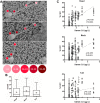Seminal cadmium affects human sperm motility through stable binding to the cell membrane
- PMID: 37274747
- PMCID: PMC10232869
- DOI: 10.3389/fcell.2023.1134304
Seminal cadmium affects human sperm motility through stable binding to the cell membrane
Abstract
Environmental pollutants are claimed to be major factors involved in the progressive decline of the fertility rate worldwide. Exposure to the heavy metal Cadmium (Cd) has been associated with reproductive toxicity due to its ionic mimicry. However, the possible direct accumulation of Cd in human sperm cells has been poorly investigated. In this study, we aimed to clarify the possible direct effect of Cd exposure on sperm function through the analysis of its cell accumulation. Semen samples from 30 male subjects residing in high environmental impact areas and adhering to the "Exposoma e Plurifocalità nella Prevenzione Oncologica" campaign for testis cancer prevention were compared with semen samples from 15 males residing in low exposure areas. Semen levels and cell Cd content were quantified by inductively coupled plasma (ICP) spectroscopy. Cell Cd distribution was assessed by scanning electron microscopy coupled with energy dispersive spectroscopy (SEM-EDS). The impact of Cd on sperm function was evaluated by the in vitro exposure to the heavy metal, whilst possible scavenging approaches/agents were assessed. In addition to higher values of semen Cd, exposed subjects showed a reduction in total motile sperm fraction compared to not-exposed controls (59.6% ± 13.6% vs. 66.3% ± 7.3%, p = 0.037). Semen Cd levels were also significantly correlated with SEM-EDS signals of Cd detected on the head and neck of sperm (respectively p = 0.738, p < 0.001 and ρ = 0.465, p < 0.001). A total of 2 h of in vitro exposure to 0.5 μM Cd was associated with a significant reduction of sperm progressive motility. Scavenging approaches with either hypo-osmotic swelling or 10 μM reduced glutathione were ineffective in blunting cell Cd and restoring motility. The reduction of exposure levels appears to be the main approach to reducing the reproductive issues associated with Cd.
Keywords: heavy metals; inductively-coupled plasma spectroscopy; ionic mimicry; scanning electron microscopy/energy dispersive spectroscopy; scavenging.
Copyright © 2023 Pappalardo, Cosci, Moro, Stortini, Sandon, De Angelis, Galdiero, Trifuoggi, Pivonello, Pedrucci, Di Nisio, Foresta, Ferlin and De Toni.
Conflict of interest statement
The authors declare that the research was conducted in the absence of any commercial or financial relationships that could be construed as a potential conflict of interest.
Figures



References
LinkOut - more resources
Full Text Sources

